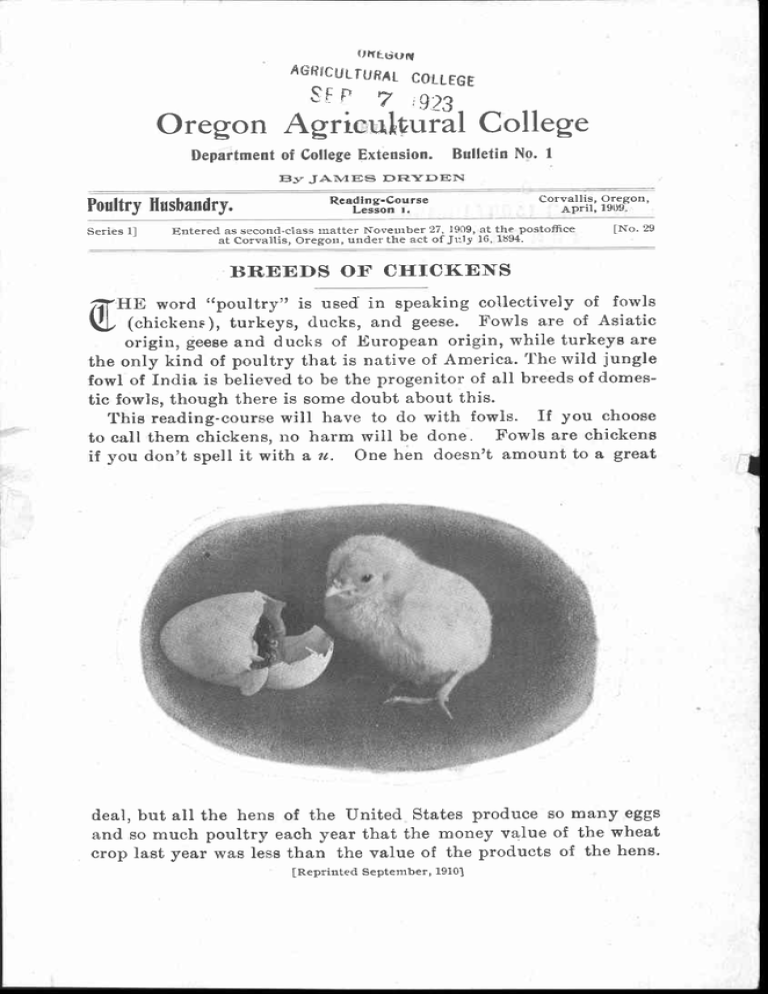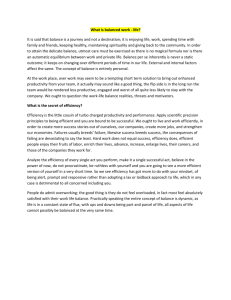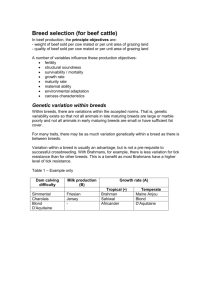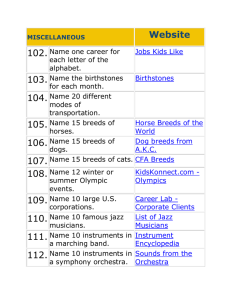Oregon Agricultural College S 7 923
advertisement

()tritium AGRICULTURAL COLLEGE S F P 7 923 Oregon Agricultural College Department of College Extension. Bulletin No. 1 By JAMES DRYDEN Poultry Husbandry. Series 1] Reading-Course Lesson I. Corvallis, Oregon, April, 1909, Entered as second-class matter November 27, 1919, at the postoffice at Corvallis, Oregon, under the act of Jaly 16, 1894. [No. 29 BREEDS OF CHICKENS HE word "poultry" is used in speaking collectively of fowls / (chickens), turkeys, ducks, and geese. Fowls are of Asiatic origin, geese and ducks of European origin, while turkeys are E the only kind of poultry that is native of America. The wild jungle fowl of India is believed to be the progenitor of all breeds of domestic fowls, though there is some doubt about this. This reading-course will have to do with fowls. If you choose to call them chickens, no harm will be done. Fowls are chickens if you don't spell it with a n. One hen doesn't amount to a great deal, but all the hens of the United States produce so many eggs and so much poultry each year that the money value of the wheat crop last year was less than the value of the products of the hens. [Reprinted September, 1910] , C 2 These products—eggs and poultry—were estimated by government officials as worth over $600,000,000 in 1908. Think of that ! Then think of this: the poultry products of Oregon last year were worth enough to pay all the appropriations made by the last legislature for two years. And yet large quantities of eggs and poultry are imported into the. state. Double the quantity could be produced in this state without overstocking the markets. There Are Many and Different Chickens.—When we speak of certain chickens as belonging to a certain breed, we mean that they fill the requirements of that breed as laid down in what is known as the American Standard of Perfection. Some one may establish a strain of fowls having some special or fancied merit and of distinct type, but it is not considered a breed in this country until it has been admitted to the Standard of Perfection. The American Poultry Association makes the Standard. This association is composed of a body of men and women interested in various ways in poultrykeeping, who meet at stated times and authorize or deny the admission of new breeds, and publish a book called the Standard of Perfection. This book describes in detail the points that make up the perfect specimen of each breed. A knowledge of these points is very essential to any one who wishes to breed fowls for show purposes. The person who follows this line of poultry-keeping is usually called a "fancier." Standard Classification.—Fowls are divided into many classes, breeds and varieties. According to the Standard of Perfection there are 11 classes, 38 breeds, and 104 varieties. In the American class there are six breeds and 17 varieties; the rest are divided among ten other classes, the principal classes being the American, English, Asiatic, and Mediterranean. The only difference, practically, between some of the breeds is a difference in color, while in many of the varieties the only difference is in color of plumage. The Standard places a high value on color. In the American class, for example, 41 points out of a possible 100 are given for color. Utility Classification.—The utility breeder, so-called, subordinates the fancy points to the utility or useful qualities of fowls. For practical, or useful, purposes, fowls may be divided into four classes: 1. Egg breeds; 2. Meat breeds; 3. General-purpose breeds; 4. Fancy breeds. 1. Egg- Breeds.—The most noteworthy characteristics of the egg breeds are, small size, active and nervous disposition, early ma- 3 turity, poor sitters, good foragers, sensitiveness to cold. The principal representatives of the egg breeds are Leghorns, Minorcas, Spanish, Andalusian, and Hamburgs. All, except the Hamburgs, belong to the Mediterranean class. 2. MealBreeds.—Among the characteristics of the meat breeds may be mentioned large size, gentleness in disposition, slow in movement; not good foragers, easily confined, as a rule poor layers, late in maturing, persistent sitters. Brahmas, Cochins and Langshans are the principal meat breeds. 3. General-purpose Breeds.—These are of medium size, good table fowls, fair layers, less active than the egg breeds, but more so than the meat breeds; good sitters and mothers. Plymouth Rocks, Wyandottes, and Rhode Island Reds belong to this class. 4. Fancy Breeds.—Bantams of various varieties, Polish and Silkies come under this head and are raised chiefly for some peculiarity of form or feather without regard to useful qualities. This class will be eliminated from any further discussion in these lessons. Which is the Most Profitable Breed ?—Before attempting an answer to this question several things should be said. (1) So far as productiveness .is concerned, there is more difference in individuals than in races or breeds of fowls. Two hens of the same breed may be so nearly alike in color and shape that they can scarcely be distinguished one from the other, but one may be a highly profitable producer of eggs and the other may not lay enough to pay for her feed. It is a difference in individuality. In late years, by a system of trap-nesting fowls, it has been found that hens vary in egg yield from less than a dozen eggs a year to more than twenty dozen, and this variation extends to all breeds and varieties. There is no shape or type, so far as known, typical of the good layer or the poor layer; in other words, it is not possible to go into a flock of fowls and separate the good from the poor layers by the' shape of the fowl. This remarkable discovery has awakened great interest in the possibilities of poultry breeding for increased egg yield. Does the hen transmit her laying qualities through the egg to the offspring ? It has never yet been clearly demonstrated that she does, but few would dare to take the ground that like does not beget like in chickens as in livestock and plants. It is with the purpose of improving the laying qualities of chickens that the government and several states are spending considerable money at experiment stations for poultry work. 4 Fowls have not been bred long enough for egg-producing qualities to establish an egg type. In the making of breeds and varieties the Standard of Perfection is the master, and it does not take into account egg records. It is to be expected, therefore, that there will be little uniformity in egg yield among individuals of the same breed or any breed. Wonderful things have been done in breeding poultry for shape and color and size. Breeders have "moulded" the hen at will and "painted" her any desired color; but heretofore owing to the difficulty of telling which hens laid the egg improvement in egg productiveness has not been so marked. (2) Remembering what has been said above that there is more difference in the hens than in the breeds, it is true nevertheless that there are some differences in breeds in egg-laying. Experiments made by the writer, covering a number of years, lead to the conclusion that the Leghorn will, on the average, lay more eggs on a given amount of food than any other breed. In the tests made the Leghorns consumed about 25 per cent less food than fowls of the American class, like the Plymouth Rocks or Wyandottes, and laid fully as many eggs. It should be expected that the heavier breeds will eat more food than the smaller breeds because they have a larger body to maintain, and, as will be explained in a later lesson, the body's wants must first be supplied from the food eaten. If it were an exclusive egg business we were engaged in, the Leghorn would make more profit than any of the larger breeds. On a question of egg production alone, the Leghorns are the most profitable producers; that is, they will produce eggs at less food cost than any other breed. (3) But eggs are not the only product of the flock. We are necessarily producing meat that has a good market value when engaged in the egg business. Egg and meat production go hand in hand. As will be explained later, the hens must be killed off at least every other year, and considerable money is made from the sale of the old hens. The Plymouth Rock or hens of that type are worth twice as much for eating as Leghorns on account of larger size and greater proportion of meat to bones. That is, there is less waste for every pound of edible meat on the Plymouth Rock, or other General-purpose fowls, than on the Leghorn. Again, in raising pullets to take the place of the old hens, as many cockerels, on the average, will be raised as pullets, and the cockerels have to be sold. The cockerels of the general-purpose or meat breeds, will 5 make greater profit to sell than those of the egg breeds. Figuring on that basis, it will be found that there is very little actual difference in the relative value of the egg and general-purpose breeds as we find them. The meat breeds are not as economical egg producers as either the egg breeds or the general-purpose breeds, and unless there is a specially good market for large fowls they have no advantage over the general-purpose breeds as market fowls. (4) Another point that should be taken into account in studying the value of different breeds is that the egg breeds are non-sitters; they do not "go broody"; at least not very often, and very rarely will a Leghorn sit the necessary time to bring off a hatch. Fowls of the general-purpose or meat classes are good sitters and mothers. This is a point in favor of these breeds, unless for special reasons incubators are used. (5) Another difference in breeds should be noted here. The Leghorns, like other egg breeds, have a nervous, active disposition; the larger breeds are more gentle. The small breeds are easily scared. A stranger visiting the yards, or a dog passing by, often frightens them badly. Hens that are frequently scared or disturbed will not lay well. Quiet and contentment are conducive to good egg yield. On this account in some places, especially in town where the fowls are liable to be frequently disturbed or scared, the larger and more gentle breeds will often give a better yield than the egg breeds. However, it is not impossible to get a good egg yield from the small breeds on a town lot. Differences in Varieties.--Between breeds or varieties of the egg breeds there are some characteristic differences. The Leghorns will lay the most eggs; the Minorcas or Spanish the largest eggs. The Leghorns are smaller in size than the Minorcas. The former have yellow skin and shanks, the latter white skin and dark shanks. In this respect the Leghorns have the advantage, as the markets prefer the yellow color. On the whole the Leghorns are the most profitable of the egg breeds. Of the different breeds and varieties of general-purpose fowls it has never yet been demonstrated that any one of them has a distinct or real advantage over the others in egg production. Strains or individuals vary, but on the average there is very little difference in the breeds or varieties of this class. As to market qualities the Plymouth Rocks, Wyandottes, and Rhode Island Reds of different varieties all meet the requirements of a good table fowl when 6 proper attention is given to the breeding and feeding. The Plymouth Rocks are a trifle heavier than either of the other breeds. They each have the yellow skin and shanks. The main differences in the three breeds mentioned is in weight and shape of body. The Plymouth Rocks have a body of medium length; the Wyandottes have a shorter body and shorter legs and a more blocky form. The Rhode Island Reds have more the shape of the Plymouth Rock but the weight of the Wyandottes. Perfect. specimens of Plymouth Rocks should weigh as follows: Cock (male 1 year old and over) 94 lbs.; cockerel (less than a year old) 8 lbs.; hen (over a year old) 74 lbs; pullet (less than a year old) 64 lbs. These are the weights given by the Standard. The Wyandottes are a pound lighter in weight. The Standard, however, does not require that all pure-bred fowls should have certain weights; they may weigh more or less than the weights given in the Standard and still be classed as purebreeds, but the nearer they approach the standard weights the better specimens of the breed they are. The Leghorns have no standard weights but they average not more than half the weight of the Plymouth Rocks. The Light Brahmas, the heaviest breed of domestic fowls, weigh: Cock, 12 lbs.; cockerel, 10 lbs.; hen, 9i lb.; pullet, 8 tbs. Varieties of Breeds.—As already explained, there are many varieties of the different breeds. The difference in varieties is one chiefly of color. This is especially true of the Leghorns, Plymouth Rocks, Wyandottes and Rhode Island Reds. It may happen that the severe inbreeding which may have been necessary to produce some varieties have injured their utility or egg-laying qualities, but as a general rule the difference in varieties is a difference in color only. The white fowls present a slightly better appearance when dressed than fowls of dark plumage, but when in prime condition and properly dressed the difference will hardly be noticeable. A Summing Up.—As a whole, the Barred Plymouth Rock is without doubt the most popular breed of chickens in this country; more of them are found on the farms than any other breed. On special poultry farms, the Leghorn is a very popular breed, while in the poultry farming districts of Rhode Island the Rhode Island Reds are almost exclusively used. As a general utility fowl the Wyandottes are second in popularity to the Rocks, the White variety being the most popular. Their blocky shape makes them an excellent breed for broilers. Like , the Plymouth Rocks and Rhode Island 7 Reds they lay a brown egg. The Leghorns lay a white egg and in this respect they have a slight advantage, as most markets prefer the white egg, though there is no difference in quality of eggs with a brown or white shell. Selecting the Chickens.—In selecting a pen of fowls for egg and meat production, there are several points to be considered, outside of the question of breed. The most important is the health and vitality of the fowls. The greatest problem in poultry-keeping is to keep up the strength and vigor of the stock. Some of the principal things that produce weakness in the fowls are inbreeding, breeding from fowls that lack in health and vitality; improper incubation A good and a poor type of chicken. The one on the right lacks vigor and market qualities, as well as beauty. and brooding; unsuitable housing; too close confinement; unclean houses and yards, lack of proper food. Constitutional weakness is shown in various ways. Small size, lack of breadth and depth of body, thin, wabbly legs and knock-knees, and shallow breast usually indicate lack of vigor. As to size it is a safe plan not to use any pure-breeds that do not come up to Standard weights. A chicken may be pure-bred and lack in some of these things. It doesn't necessarily follow that because a chicken is pure-bred it is profitable to keep. In purchasing be careful to select fowls having vigor, alertness and size. Better have a vigorous "mongrel" than a purebreed lacking in stamina. Does It Pay to Keep Pure breeds? —Generally speaking it does. One 8 advantage of the pure-breeds is that the offspring are more uniform in size and shape. Uniformity of product, whether of eggs or dressed chicken, has a market value. The barnyard fowl with a mixed ancestry will usually produce chickens of different sizes, different shapes, different color of skin and legs, and varying in quality of flesh. In such a flock, one may have the size and characteristics of the egg breeds, another of the meat breeds, etc. The color and size of the egg will also vary. The main advantage of the purebreeds is that you get a more uniform product from them than from the mixed fowls. The pure-breeds should lay more eggs than the "mongrels," granting that they have equal stamina. Then of course the pure-breeds are more attractive in appearance than the mixed chickens, and as many people keep chickens both for pleasure and profit the uniformity in color and shape of the pure-breeds should he considered. On the whole, both for utility as well as fancy considerations the pure-breeds have advantages over the mongrel fowls. The thing to be avoided, however, is the buying of chickens just because they are pure-breeds, for there are "mongrel" pure-breeds, so far as vigor and profit-making capacity are concerned. A distinction should be made between "mongrels" and "crossbreeds." Crossing of pure-breds is sometimes a decided advantage. The offspring very often have greater stamina than the pure-breds. The first cross will usually give good results, but in breeding the crosses together the results are likely to be disappointing. If crossbred hens are used for breeding a pure-bred male should be mated with them. What is a Good Egg Yield ?—An average of 150 eggs per hen during the first year of laying is good laying. Pullets in good health and vigor should average this number of eggs. During the second year they will lay about 25 per cent fewer eggs, and each succi eding year correspondingly fewer. REFERENCE.—Taose wishing other reading on the subject of breeds of fowls may obtain, free, Farmers' Bulletin No. 51 on Standard Varieties of Chickens, by addressing the U. S. Dept. of Agriculture, Washington, D. C.







